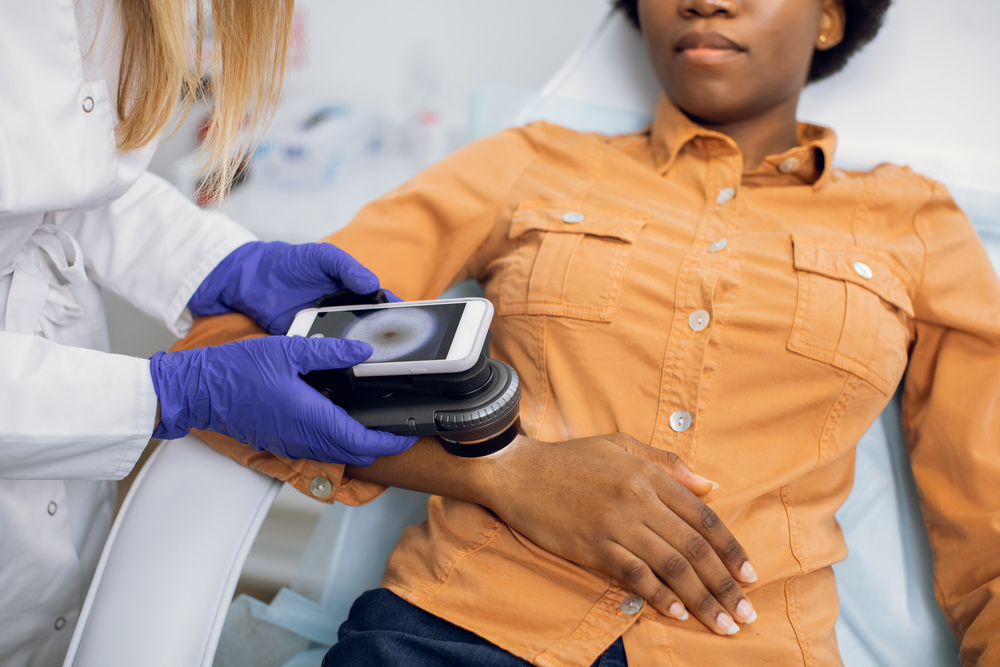Melanoma is a type of skin cancer that develops from melanocytes, cells responsible for skin pigmentation. While individuals with darker skin, like many African Americans, benefit from higher melanin levels, which provide some natural protection from ultraviolet (UV) radiation, this protection is not foolproof. Recent research suggests that genetic factors, along with non-UV-related mutations, play an increasingly important role in melanoma development among African Americans.
While melanoma is less common in African American communities compared to those with lighter skin, the consequences can be more severe. The stark disparity in survival rates — with a 71% five-year survival rate for Black individuals versus 94% for white individuals — highlights the severity of these challenges. Delayed diagnoses and the distinct ways melanoma manifests in darker skin contribute to this difference.
Unique presentation patterns
Melanoma in African American skin often presents in ways that differ from traditional descriptions of the disease. In individuals with darker skin, melanoma is more likely to appear in areas with minimal sun exposure, such as:
- The palms of the hands
- The soles of the feet
- Under the fingernails or toenails
- On mucous membranes
These locations contrast sharply with the typical sites of melanoma in lighter skin, which usually develops on sun-exposed areas like the back, chest, and face. As a result, healthcare professionals may struggle to identify melanoma in African Americans, especially when it doesn’t match the patterns they are trained to recognize.
Detection challenges
Melanoma detection remains a major challenge in African American communities, where several factors complicate early diagnosis. These challenges include clinical obstacles such as the different ways melanoma manifests in darker skin, and the limited availability of medical imaging examples showing melanoma in such skin types. Additionally, early signs of melanoma in African American skin may be less visible to the untrained eye, further delaying diagnosis.
Systemic barriers also play a significant role in these challenges. African American communities often face reduced access to dermatologists and lower rates of skin cancer screenings. This is compounded by limited insurance coverage, healthcare access disparities, and a lack of provider diversity, which makes it harder for Black patients to receive the care they need.
Health equity considerations
Melanoma in African Americans is not just a clinical issue — it’s a social one. Healthcare access is a major determinant of outcomes, and several social factors influence melanoma diagnosis and treatment in communities of color. Geographic distribution of healthcare specialists means that many African Americans may have limited access to dermatologists or skin cancer screening services, particularly in rural or underserved urban areas. Insurance coverage gaps and transportation barriers further hinder access to timely care, leaving many at risk for later-stage diagnoses.
Economic barriers and limited educational opportunities also play a role, as individuals in these communities may lack knowledge about melanoma risk factors and the importance of early detection. Environmental factors, including exposure to UV radiation in certain regions, may also contribute to health disparities in melanoma rates. Addressing these systemic issues is vital to improving melanoma outcomes for African Americans and advancing health equity overall.
Prevention strategies
Effective melanoma prevention for African Americans requires a multi-faceted approach. While sun exposure remains a risk factor, the focus should be on practical, daily strategies for skin protection. Wearing broad-spectrum sunscreen with an SPF of 30 or higher, dressing in protective clothing, and seeking shade during peak sunlight hours are key habits to adopt. Avoiding tanning beds and regularly examining the skin can also help detect early signs of melanoma before it becomes a more significant issue.
Healthcare engagement is another crucial element in melanoma prevention. African Americans should undergo regular medical check-ups and skin cancer screenings, especially if they have a family history of skin cancer or other risk factors. It’s essential to engage with healthcare providers, document a family history of melanoma, and discuss individual risk factors. Early diagnosis is one of the most effective ways to improve melanoma survival rates, making healthcare engagement a priority.
Early detection guidelines
Detecting melanoma early can significantly improve outcomes. For individuals with darker skin, a modified approach to skin self-examinations is necessary. Regular self-exams should include checking the palms, soles, and nail beds, as well as mucous membranes and the scalp. It’s also important to watch for any new or changing spots, irregular borders, or areas with multiple colors within lesions. Non-healing sores or marks that grow or evolve should also be brought to a healthcare provider’s attention.
While melanoma may not always present in typical locations or ways, developing an understanding of what to look for is crucial. Recognizing warning signs, such as changes in the skin, and seeking timely medical advice can save lives. Early detection is key to reducing the mortality rates associated with melanoma.
Moving forward
Addressing melanoma disparities in African American communities requires a concerted, multi-pronged approach. Immediate actions include expanding access to healthcare, improving provider education, and increasing community awareness about melanoma’s risks and early signs. More research into melanoma’s genetic risk factors and how it affects different populations is also essential.
Long-term goals must focus on reducing the survival gap between African Americans and other groups, improving early detection, and enhancing access to treatment. By strengthening prevention programs, addressing health equity issues, and supporting targeted interventions, the health outcomes for African Americans diagnosed with melanoma can be dramatically improved.
In conclusion, melanoma remains a significant health threat for African Americans, but with greater awareness, improved access to healthcare, and continued research, the outlook can be more optimistic. It’s vital to continue bridging gaps in diagnosis, treatment, and prevention to ensure that everyone has an equal opportunity for a long and healthy life.















